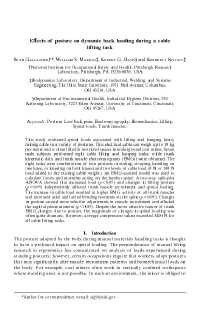Mining Publication: Effects of Posture on Dynamic Back Loading During a Cable Lifting Task
Original creation date: April 2002
This study evaluated spinal loads associated with lifting and hanging heavy mining cable in a variety of postures. This electrical cable can weigh up to 10 kg per metre and is often lifted in restricted spaces in underground coal mines. Seven male subjects performed eight cable lifting and hanging tasks, while trunk kinematic data and trunk muscle electromyograms (EMGs) were obtained. The eight tasks were combinations of four postures (standing, stooping, kneeling on one knee, or kneeling on both knees) and two levels of cable load (0 N or 100 N load added to the existing cable weight). An EMG-assisted model was used to calculate forces and moments acting on the lumbar spine. A two-way split-plot ANOVA showed that increased load (p < 0.05) and changes in lifting posture (p < 0.05) independently affected trunk muscle recruitment and spinal loading. The increase in cable load resulted in higher EMG activity of all trunk muscles and increased axial and lateral bending moments on the spine (p < 0.05). Changes in posture caused more selective adjustments in muscle recruitment and affected the sagittal plane moment (p < 0.05). Despite the more selective nature of trunk EMG changes due to posture, the magnitude of changes in spinal loading was often quite dramatic. However, average compression values exceeded 3400 N for all cable lifting tasks.
Authors: S Gallagher, WS Marras, KG Davis, K Kovacs
Peer Reviewed Journal Article - April 2002
NIOSHTIC2 Number: 20022728
Ergonomics 2002 Apr; 45(5):380-398
See Also
- Biomechanical Modeling of Asymmetric Lifting Tasks in Constrained Lifting Postures
- A Comparison of Fatigue Failure Responses of Old Versus Middle-Aged Lumbar Motion Segments in Simulated Flexed Lifting
- Effects of Lifting in Four Restricted Postures
- Effects of Posture on Back Strength and Lifting Capacity
- An Exploratory Study of Loading and Morphometric Factors Associated with Specific Failure Modes in Fatigue Testing of Lumbar Motion Segments
- Nature and Cost of Low Back Pain
- Reducing Low Back Pain and Disability in Mining
- Technology News 521 - Development of a Mobile Manipulator to Reduce Lifting Accidents
- Torso Flexion Loads and Fatigue Failure Mode of Human Lumbosacral Motion Segments
- Trunk Extension Strength and Muscle Activity in Standing and Kneeling Postures
- Content source: National Institute for Occupational Safety and Health, Mining Program


 ShareCompartir
ShareCompartir
